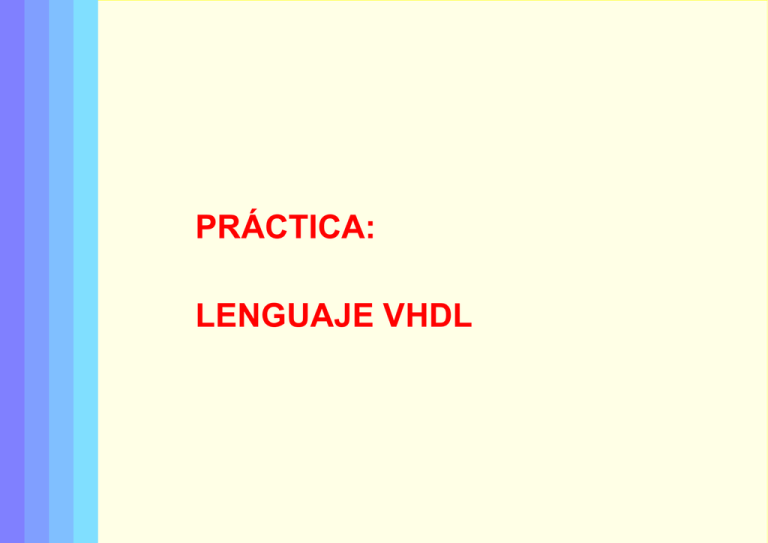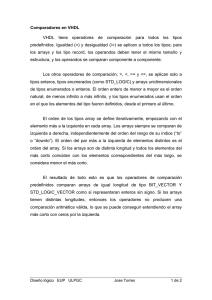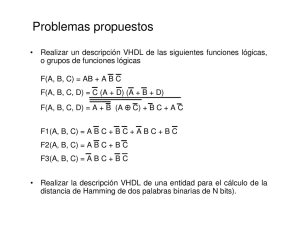PRÁCTICA: LENGUAJE VHDL
Anuncio

PRÁCTICA: LENGUAJE VHDL Introducción Los lenguajes permiten manejar mejor grandes tamaños Los lenguajes son más flexibles que las tablas Los lenguajes son légibles por las máquinas más fácilmente que los gráficos Los lenguajes son más comprensibles que los métodos matemáticos DOCUMENTACIÓN SIMULACIÓN VERIFICACIÓN FORMAL SÍNTESIS VHDL SISTEMAS ANALÓGICOS Lenguaje VHDL MODELADO DE RENDIMIENTOS DIAGNOSIS DE FALLOS Y GENERACIÓN DE TEST ENTIDAD A(0) B(0) A(1) B(1) A(2) B(2) A(3) B(3) Estructura Conexión con el exterior >2 ‘0’ >2 S(0) >2 S(1) Propiedades genéricas >2 S(2) S(3) S(4) ARQUITECTURA A(0) B(0) A(1) B(1) A(2) B(2) A(3) B(3) Descripción estructural Descripción de comportamiento ‘0’ Lenguaje VHDL >2 >2 S(0) >2 S(1) Descripción de flujo de datos >2 S(2) S(3) S(4) Estructura Lenguaje VHDL entity sumador is port( A, B, Cin suma end sumador; : in std_logic_vector(3 downto 0); : out std_logic_vector(4 downto 0)); architectura estructura of sumador is signal s1 : std_logic_vector(3 downto 0); component xor port( A, B, C : in std_logic; Y : out std_logic); end component; component mayor port( A, B, C : in std_logic; Y : out std_logic); end component; for all:xor use entity work.xor; for all:mayor use entity work.mayor; begin B1:xor port map (A(0), B(0), ‘0’, suma(0)); M1:mayor port map (A(0), B(0), ‘0’, S1(0)); B2:xor port map (A(1), B(1), S1(0), suma(1)); M2:mayor port map (A(1), B(1), S1(0), S1(1)); B3:xor port map (A(2), B(2), S1(1), suma(2)); M3:mayor port map (A(2), B(2), S1(1), S1(2)); B4:xor port map (A(3), B(3), S1(2), suma(3)); M4:mayor port map (A(3), B(3), S1(2), suma(4)); end; architectura flujo of sumador is signal s1 : std_logic_vector(2 downto 0); begin suma(0) <= A(0) xor B(0); S1(0) <= A(0) and B(0); suma(1) <= A(1) xor B(1) xor S1(0); S1(1) <= (A(1) and B(1)) or (A(1) and S1(0)) or (B(1) and S1(0)); suma(2) <= A(2) xor B(2) xor S1(1); S1(2) <= (A(2) and B(2)) or (A(2) and S1(1)) or (B(2) and S1(1)); suma(3) <= A(3) xor B(3) xor S1(2); suma(4) <= (A(3) and B(3)) or (A(3) and S1(2)) or (B(3) and S1(2)); end; ESQUEMA GENÉRICO DE LA ENTIDAD Estructura entity <NOMBRE> is generic(<PROPIEDAD> <PROPIEDAD> port( <NODO><, NODO> <NODO><, NODO> <NODO><, NODO> end <NOMBRE>; : <TIPO> := <VALOR>; : <TIPO> := <VALOR>); : <SENTIDO> <TIPO>; : <SENTIDO> <TIPO>; : <SENTIDO> <TIPO>); SENTIDOS DE SEÑAL IN --> SEÑAL DE ENTRADA. NO SE LE PUEDE ASIGNAR NINGÚN VALOR EN EL INTERIOR DEL MODELO OUT --> SEÑAL DE SALIDA. DEBE SER ASIGNADA. NO SE PUEDE TOMAR COMO DATO DE UN ASIGNAMIENTO INOUT --> SEÑAL DE ENTRADA/SALIDA. SE LE PUEDE ASIGNAR UN VALOR, Y SER DATO DE UN ASIGNAMIENTO. TIPOS PREDEFINIDOS BIT (VALORES: 0, 1) BIT_VECTOR (VECTOR DE N BITS) STD_LOGIC (VALORES: 0, 1, X, Z, H, L) Lenguaje VHDL STD_LOGIC_VECTOR (VECTOR DE N STD_LOGIC) tructura ESQUEMA GENÉRICO DE LA ARQUITECTURA architecture <NOMBRE> of <NOMBRE ENTIDAD> is <PARTE DECLARATIVA DEL CUERPO DE LA ARQUITECTURA> begin <CUERPO DE LA ARQUITECTURA> end; PARTE DECLARATIVA SEÑALES INTERNAS TIPOS type <NOMBRE> is (<VALOR1>, <VALOR2); signal <NOMBRE> : <TIPO>; COMPONENTES component <NOMBRE> port(<NOMBRE> : <DIRECCIÓN> <TIPO>); end component; for <ETIQUETAS>:<NOMBRE> use entity <LIBRERIA>.<ENTIDAD>(<ARQUITECTURA>); Lenguaje VHDL CUERPO DE LA ARQUITECTURA Estructura OPERADORES DESCRICPCIÓN DE FLUJO DE DATOS Lenguaje VHDL DECLARACIONES CONCURRENTES DECLARACIONES SECUENCIALES DESCRICPCIÓN DE ESTRUCTURA DESCRICPCIÓN DE ALGORITMO DEFINICIÓN DE NUEVOS TIPOS Tipos de señal Tipos enumerados type <NOMBRE> is (<VALOR><, <VALOR>, <VALOR>); type bit is (‘0’, ‘1’); type triestado is (‘0’, ‘1’, ‘Z’); type estados_sistema is (desocupado, test, evaluando); type <NOMBRE> is range <VALOR INICIAL> to <VALOR FINAL>; type enteros_pequeños is range 0 to 9; type reales_pequeños is range 0.0 to 1.0; type tiempo is range -(2**31-1) to 2**31-1 Tipos matriciales type <NOMBRE> is array (<VALOR INICIAL> to <VALOR FINAL>) of <TIPO>; type <NOMBRE> is array (<TIPO DE RANGO> range <>) of <TIPO>; type bit_vector is array (integer range <>) of bit; type matriz is array (integer range <>, integer range <>) of reales_pequeños; Lenguaje VHDL type mi_bit is array (triestado range ‘0’ to ‘1’) of bit; Tipos registros Tipos de señal type <NOMBRE> is record <NOMBRE1><,<NOMBRE11>>: <TIPO>; <NOMBRE2><,<NOMBRE21>: <TIPO>; end record; type coordenadas is record X, Y: enteros_pequeños; end record; type par_lógica_tiempo is record valor_lógico: bit_vector(9 downto 0); valor_temporal: tiempo; end record; signal S1, S2: par_lógica_tiempo; signal C1, C2: coordenadas; C1.X <= 8; C1.Y <= 9; C2 <= C1; S1.valor_lógico(6) <= ‘0’; S2.valor_lógico <= “0101010101”; ----------------> S2.valor_lógico(9) = 0 Lenguaje VHDL atributos -> referencia a carácterísticas de tipos Tipos de señal atributos que devuelven elementos ‘left -> devuelve el elmento de la izquierda de la lista ‘right -> devuelve el elemento de la derecha de la lista ‘high -> devuelve el mayor elemento de la lista ‘low -> devuelve el menor elemento de la lista ‘succ(<ELEmento>) -> devuelve el siguiente elemento al indicado ‘val(<índice>) -> devuelve el elemento correspondiente al índice ‘pred(<elemento>) -> devuelve el elemento anterior al indicado atributos que devuelven un valor ‘pos(<elemento>) -> devuelve el índice correspondiente al elemento ‘stable -> cierto cuando la no hay cambio en la señal ‘event -> cierto cuando hay cambio en la señal ‘range -> devuelve el rango del tipo ‘length -> devuelve la longitud del tipo atributos que devuelven una señal ‘delayed(<N>) -> devuelve la misma señal retrasada n segundos Lenguaje VHDL Asignamiento Asignamiento de señales: forma básica de modelar un comportamiento en vhdl dato <= ‘0’, ‘1’ after 5ns, ‘0’ after 20ns, ‘1’ after 22ns, ‘0’ after 25ns; a <= dato; -- A ES UNA COPIA IDÉNTICA DE DATO b <= dato after 10ns; -- B ES UNA COPIA DE DATO RETRASADA INERCIALMENTE 10ns c <= transport dato after 10ns -- C ES UNA COPIA DE DATO RETRASADA IDEALMENTE 10ns dato A B C 0ns Lenguaje VHDL 10ns 20ns 30ns 40ns Operaciones Operaciones lógicas and --> S1 <= A and B and C; OR --> S1 <= A or B or C; xor --> S1 <= A xor B xor C; NAND --> S1 <= (A nand B) nand C; NOR --> S1 <= (A nor b) nor C; not --> S1 <= not A; aritméticas + --> suma - --> resta * --> multiplicación / --> división ** --> potenciación abs --> valor absoluto relacionales = /= < <= > >= Lenguaje VHDL --> igual --> distinto --> menor --> menor o igual --> mayor --> mayor o igual Declaraciones concurrentes Selección with <EXPRESIÓN> select <SEÑAL> <= <EXPR1> when <VALOR>, <EXPR2> when <VALOR>; Declaraciones Componente <ETIQUETA>: <COMPONENTE> port map (<SEÑALES>); Asignamiento condicional <SEÑAL> <= <EXPR1> when <CONDICIÓN> else <EXPR2>; Bucle <ETIQUETA>: for <ÍNDICE> in <RANGO> generate begin <INSTRUCCIONES CONCURRENTES> end generate; Bloque <ETIQUETA>: block (<CONDICIÓN>) <PARTE DECLARATIVA begin <INSTRUCCIONES> <SEÑAL> <= guarded <EXPR>; end block <ETIQUETA>; Avisos Lenguaje VHDL Procesos <ETIQUETA>: process (<LISTA DE SENSIBILIDAD>) <PARTE DECLARATIVA begin <INSTRUCCIONES SECUENCIALES> end process <ETIQUETA>; assert <CONDICIÓN> report <MENSAJE> severity <TIPO DE AVISO>; -- LOS TIPOS DE AVISO PUEDEN SER NOTE, WARNING, -- ERROR y FAILURE. Declaraciones secuenciales Declaraciones Condicional Espera wait on <SEÑAL>; wait for <TIEMPO>; wait until <CONDICIÓN>; Selección <ETIQUETA> : case <EXPRESIÓN> is when <VALOR> => <INSTRUCCIONES> when others => <INSTRUCCIONES> end case <ETIQUETA>; Bucles <ETIQUETA>: for <ÍNDICE> in <RANGO> loop <INSTRUCCIONES SECUENCIALES> end loop; <ETIQUETA>: if <CONDICIÓN> then <INSTRUCCIONES> elseif <CONDICIÓN2> then <INSTRUCCIONES> else <INSTRUCCIONES> end if <ETIQUETA>; <ETIQUETA>: while <CONDICIÓN> loop <INSTRUCCIONES SECUENCIALES> end loop; <ETIQUETA>: loop <INSTRUCCIONES SECUENCIALES> next <ETIQUETA> when <CONDICIÓN>; exit <ETIQUETA> when <CONDICIÓN>; end loop <ETIQUETA>; Lenguaje VHDL Librerías Librerías Declaración de Paquetes Cuerpo de Paquetes package <NOMBRE> is <PARTE DECLARATIVA> end <NOMBRE>; package body <NOMBRE> is <DEFINICIONES> end <NOMBRE>; package funciones_triestado is type triestado is (‘0’, ‘1’, ‘Z’); function “andt” (X, Y : triestado) return triestado; function “ort” (X, Y: triestado) return triestado; function “nott” (X : triestado) return triestado; end funciones_triestado; package body funciones_triestado is function “andt” (X, Y : triestado) return triestado is signal resultado: triestado; begin process (X) begin Lenguaje VHDL if X = ‘0’ then resultado <= ‘0’; elseif X = ‘1’ then resultado <= Y; elseif Y = ‘0’ then resultado <= ‘0’; else resultado <= Y; end if; end process; end “andt”; Referenciando Librerías Librerías library <NOMBRE1>, <NOMBRE2>, <NOMBRE3>; library aritmética; Referencia a paquetes use <LIBRERIA>.<PAQUETE>.<ELEMENTO>; use work.sumador; use work.funciones_triestado.all; use work.funciones_triestado.andt; use std.standard.bitl; use std.textio.all; use aritmética.funciones_triestado.triestado; for <ETIQUETA>:<ENTIDAD> use entity <LIBRERIA>.<ENTIDAD>(<ARQUITECTURA>); for all:sumador use entity work.sumador; Lenguaje VHDL Ejemplo Lenguaje VHDL library IEEE; use IEEE.STD_LOGIC_1164.ALL; use IEEE.STD_LOGIC_ARITH.ALL; use IEEE.STD_LOGIC_UNSIGNED.ALL; -- Uncomment the following lines to use the declarations that are -- provided for instantiating Xilinx primitive components. --library UNISIM; --use UNISIM.VComponents.all; entity sumador4 is Port ( a : in std_logic_vector(3 downto 0); b : in std_logic_vector(3 downto 0); cin : in std_logic; suma : out std_logic_vector(3 downto 0); cout : out std_logic); end sumador4; architecture Behavioral of sumador4 is signal carry :std_logic_vector(4 downto 0); begin carry(0) <= cin; F1:for i in a'range generate begin suma(i) <= a(i) xor b(i) xor carry(i); carry(i+1) <= (carry(i) and (a(i) or b(i))) or (a(i) and b(i)); end generate; cout <= carry(4); end;

